AI (artificial intelligence) is a transformative tool that’s reshaping the workforce as we know it.
AI’s journey from a conceptual marvel to a practical asset in business has been rapid and impactful. Its ability to learn, adapt, and augment human capabilities is not just a technological leap but a paradigm shift in how work is conducted.
This shift leads us to what is now known as the AI-augmented workforce – a blend of human intelligence and machine efficiency that opens up new frontiers for productivity and innovation.
For your business, embracing an AI-augmented workforce means more than just digital adoption.
Creating an AI-augmented workforce means reimagining:
- How tasks are accomplished
- How decisions are made
- How your business grows in an increasingly digital world
AI brings with it the promise of heightened efficiency, sharper insights, and the potential to unlock levels of productivity previously unattainable.
But why is this important now?
In this article, you’ll uncover the layers of an AI-augmented workforce. We’ll explore its benefits, challenges, and key success strategies.
We aim to equip you with the knowledge and tools you need to thrive in a future where AI is a fundamental part of the workforce.
Why Is An AI-Augmented Workforce Important?
A 2023 McKinsey survey found that 55% of businesses have adopted AI in some form, and according to research from PWC, AI will boost the global economy by $15.7 trillion by 2030.
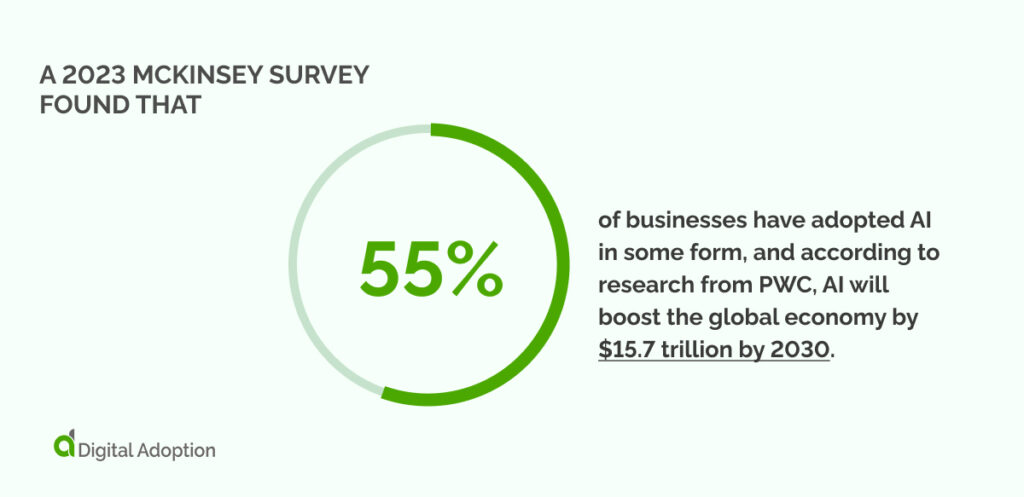
Furthermore, Forrester Analyst Rowan Curran predicts that 10% of employees will use generative AI in 2023. A 2023 Gartner survey found that 42% of HR leaders expected entry-level positions to be significantly impacted by AI.
That said, while adoption is high, most businesses have yet to realize the true power of AI. Another McKinsey report found that while 75% of companies in the metals and mining industry have implemented some form of AI, less than 15% have realized a meaningful impact.
This suggests that your competitors are likely already experimenting with an AI-augmented workforce, though they may not have mastered the art yet. It also poses a challenge—disregarding AI may result in falling behind. However, it presents an opportunity. With the right strategy, you could use an AI-augmented workforce to drive value and leapfrog the competition.
Key Benefits of an AI-augmented Workforce
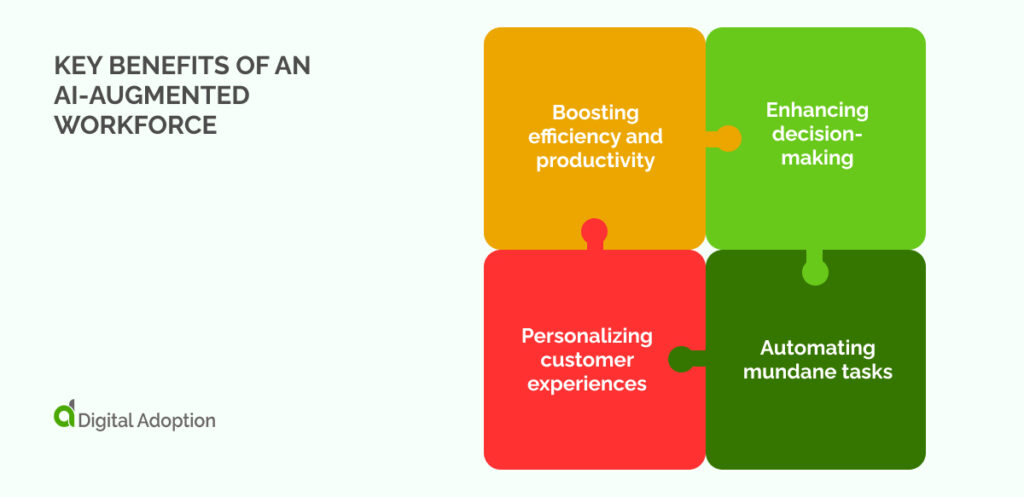
Embracing AI in your organization isn’t just about keeping up with technology; it’s about fundamentally enhancing how your business operates.
Integrating AI into your workforce paves the way for a more efficient, insightful, and customer-centric business model.
Here’s how AI can revolutionize your organization’s efficiency, decision-making, and customer engagement.
Boosting efficiency and productivity
Imagine AI as your ultra-efficient assistant, tirelessly analyzing and processing data, offering insights that can transform your operations.
With AI, you’re not just working faster; you’re working smarter.
AI-driven tools can predict market trends, optimize supply chains, and even manage your inventory in real-time, leading to significant time and cost savings.
This level of efficiency doesn’t just help you do things quicker. It enables you to unlock new opportunities for growth and innovation.
Enhancing decision-making
Decision-making is the cornerstone of successful leadership, and AI is here to bolster it.
AI’s analytical prowess means you can access deeper insights and forecasts, empowering you to make more informed, strategic decisions.
Whether identifying new market opportunities or mitigating potential risks, AI equips you with a forward-thinking approach, essential for navigating today’s dynamic business environment.
Automating mundane tasks
AI’s ability to automate routine tasks is a game-changer for your workforce.
From scheduling to complex data analysis, AI can handle these tasks with precision and consistency, freeing up your team to focus on creative and strategic initiatives.
This shift drives productivity and enhances job satisfaction as your employees engage in more meaningful and impactful work.
Personalizing customer experiences
In the era of personalization, AI is your key to delivering customized experiences to your customers.
From personalized marketing messages to tailored product recommendations, AI’s data-driven insights enable you to connect with your customers on a more personal level.
Leveraging personalization enables you to impress customers, cultivate enduring relationships, foster loyalty, and drive sales.
AI-Augmented Workforce Challenges
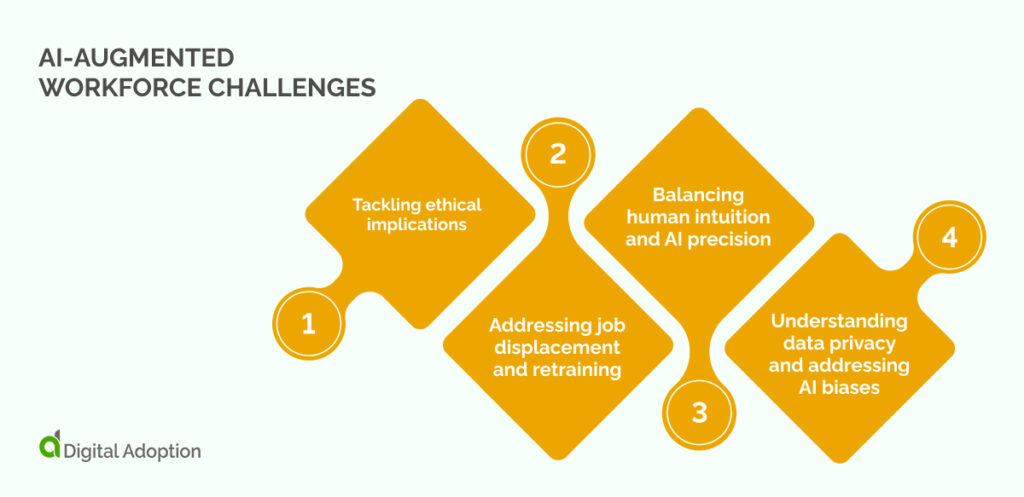
Digital adoption always comes with its share of challenges.
Creating an AI-augmented workforce is no different. AI risk management has become a school of thought in and of itself.
You must be prepared to navigate these key challenges and considerations to ensure your integration is effective, responsible, and sustainable.
Tackling ethical implications
Integrating AI into your business raises important ethical questions.
You need to consider how AI decisions are made and their impact on your stakeholders. Issues like transparency in AI decision-making and ensuring that AI-driven actions align with your company’s ethical standards are paramount.
It’s about maintaining a balance where AI enhances operations without compromising ethical values.
Addressing job displacement and retraining
The advent of AI in the workplace brings concerns about job displacement. As a leader, it’s your responsibility to address these concerns proactively.
This challenge can be turned into an opportunity by focusing on retraining and upskilling your workforce.
Investing in your employee’s education and training in AI and related technologies mitigates the risk of job displacement and empowers your team with future-ready skills.
Balancing human intuition and AI precision
AI brings precision and efficiency, but it’s essential to remember that it doesn’t replace the human element.
Finding the right balance between human intuition and AI-driven data is key. Human empathy, creativity, and strategic thinking, when combined with AI’s data processing capabilities, create a powerful synergy.
Encourage your teams to leverage AI as a tool that complements their skills rather than a replacement.
Understanding data privacy and addressing AI biases
In an AI-driven business environment, data privacy has become more critical than ever.
You must ensure that customer and employee data are handled responsibly and comply with all relevant laws and regulations.
Additionally, AI systems are only as unbiased as the data they’re trained on. Actively work to identify and eliminate biases in your AI models to ensure fairness and impartiality in AI-driven decisions.
10 Steps for Implementing an AI-Augmented Workforce
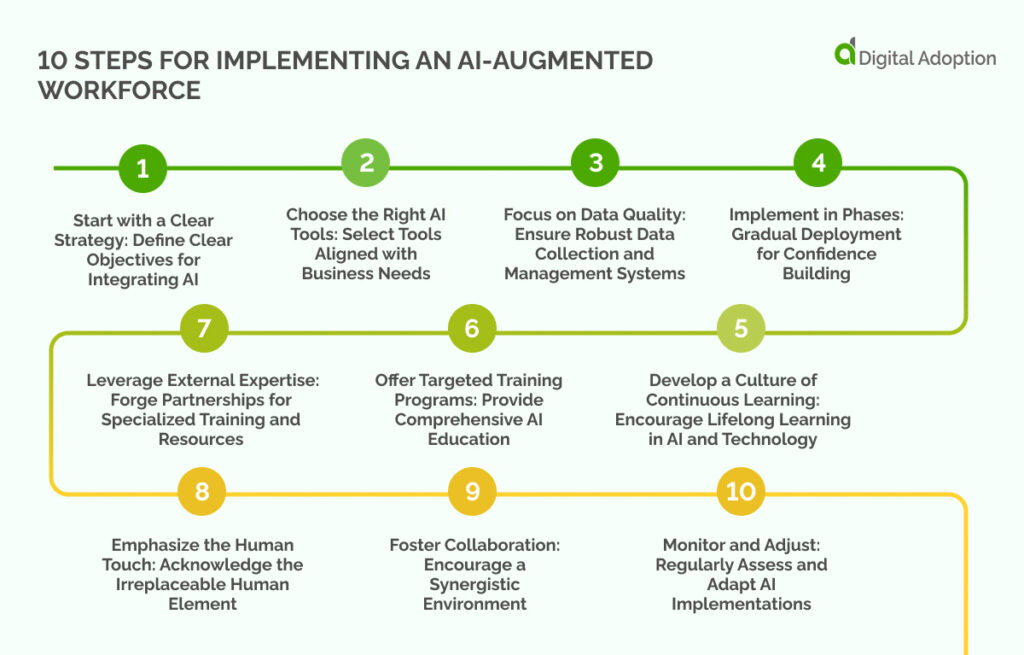
Investing in an AI-augmented workforce can be a transformative move for your organization, but it requires careful planning and strategic execution.
Here are ten essential strategies to help you ensure a seamless integration of AI into your business operations while preparing your employees for an AI-enhanced future.
Following these strategies ensures the technical success of integrating AI into your workforce, alignment with broader business objectives, and support for your most valuable asset: your employees.
1. Start with a Clear Strategy: Define Clear Objectives for Integrating AI
Initiating an AI integration journey requires a comprehensive strategy, starting with articulating objectives.
Clearly outline the intended outcomes, whether they revolve around improving operational efficiency, elevating customer experiences, or fostering innovation within the organization. This clarity serves as a guiding light for the implementation process and establishes measurable benchmarks for success.
Understanding the specific goals of incorporating AI ensures that the technology aligns with the overall vision and mission of the company.
2. Choose the Right AI Tools: Select Tools Aligned with Business Needs
Not all AI tools are created equal, and the selection process must carefully consider the business’s unique requirements.
Align the chosen AI solutions with the specific needs and challenges faced by the organization. The selected technologies should seamlessly integrate with existing systems, whether machine learning algorithms, natural language processing tools, or computer vision applications.
This strategic alignment enhances the efficacy of AI implementation and ensures a harmonious coexistence with established workflows.
3. Focus on Data Quality: Ensure Robust Data Collection and Management Systems
Organizations must prioritize establishing robust data collection and management systems because AI systems inherently depend on data.
The quality of input data directly impacts the accuracy and effectiveness of AI outcomes. Implementing stringent data collection practices, addressing biases, and maintaining data integrity throughout its lifecycle are critical steps.
This focus on data quality enhances the reliability of AI-driven insights and contributes to building trust in the technology across the organization.
4. Implement in Phases: Gradual Deployment for Confidence Building
Rather than opting for an all-encompassing approach, organizations should initiate AI integration through phased implementation.
Starting with smaller, manageable projects allows the team to gain confidence and expertise in handling AI tools.
This gradual deployment strategy minimizes the risk of disruptions, provides valuable learning experiences, and facilitates a smoother transition toward broader AI adoption as the organization becomes more adept at leveraging the technology.
5. Develop a Culture of Continuous Learning: Encourage Lifelong Learning in AI and Technology
Cultivating a culture of continuous learning is paramount in the rapidly evolving landscape of AI and technology.
Organizations should encourage employees to embrace lifelong learning, particularly in AI-related areas.
This commitment to ongoing education ensures that the workforce remains agile and adaptable, equipped with the skills to navigate the evolving AI landscape and contribute meaningfully to the organization’s AI-driven initiatives.
6. Offer Targeted Training Programs: Provide Comprehensive AI Education
Beyond general encouragement, organizations should invest in targeted training programs that cater to varying levels of familiarity with AI.
This includes basic AI literacy programs for all employees, ensuring a foundational understanding of AI principles. Simultaneously, advanced courses should be available for those directly involved in managing AI systems, equipping them with the specialized knowledge required for effective implementation and optimization.
7. Leverage External Expertise: Forge Partnerships for Specialized Training and Resources
Recognizing the dynamic nature of AI, organizations should explore partnerships with educational institutions and tech firms.
These collaborations provide access to specialized AI training programs and resources that may not be readily available in-house.
Leveraging external expertise enhances the organization’s ability to stay at the forefront of AI advancements and facilitates knowledge transfer between industry experts and internal teams.
8. Emphasize the Human Touch: Acknowledge the Irreplaceable Human Element
While AI brings unprecedented capabilities, it’s crucial to remind the team that the human element remains irreplaceable.
Creativity, empathy, and strategic thinking are uniquely human qualities that complement AI’s analytical prowess.
Reinforcing the importance of these human-centric skills fosters a balanced perspective, positioning AI as a tool designed to enhance, rather than replace, the distinct strengths that individuals bring to the table.
9. Foster Collaboration: Encourage a Synergistic Environment
Actively fostering collaboration between AI and human intelligence is integral to a successful integration strategy.
Create an environment where both elements complement each other’s strengths. Emphasize that AI is a collaborative tool designed to amplify human capabilities, encouraging cross-functional teamwork.
This collaborative mindset not only maximizes the benefits of AI but also promotes a positive and inclusive organizational culture.
10. Monitor and Adjust: Regularly Assess and Adapt AI Implementations
A crucial component of effective AI integration is continuously monitoring and assessing its impact on the workforce.
Regularly evaluate how AI implementations are influencing operations and employee experiences. This proactive approach enables organizations to identify any challenges or concerns early on and facilitates necessary adjustments.
The ability to adapt ensures that AI remains an empowering force within the organization, aligning with the overarching goal of enhancing rather than hindering the workforce’s capabilities.
The Future of the AI-Augmented Workforce
Staying at the forefront of technological advancements, especially in AI, is crucial for maintaining a competitive edge.
Here’s a look at what you can expect in the near future and how these developments might influence your business strategy:
Emerging AI technologies
The landscape of AI is continuously evolving, with new technologies always emerging.
Keep an eye on advancements like quantum computing, which could exponentially increase AI’s data processing capabilities, and augmented reality (AR) integrated AI, which might revolutionize customer service and retail experiences.
Machine learning algorithms are becoming more sophisticated, enabling predictive analytics to reach new heights of accuracy.
Staying informed about these technologies will help you identify new opportunities for your business.
Reshaping job roles and industry landscapes
AI is set to redefine job roles across various industries.
Repetitive and data-intensive roles will likely be automated, while new positions focused on managing and interpreting AI systems are expected to emerge.
Industries like healthcare, finance, and manufacturing are already seeing a shift, with AI-enhancing diagnostic accuracy, financial analysis, and production efficiency.
As a leader, you should anticipate these changes and plan how your organization can adapt to these evolving roles.
Evolving dynamics between human workers and AI systems
The relationship between human workers and AI is evolving into a more collaborative dynamic.
Humans and AI systems are likely to work in tandem, with AI handling data-driven tasks and humans focusing on areas requiring emotional intelligence and creative thinking.
This shift calls for a change in workforce training and development, emphasizing skills that complement AI capabilities.
Embrace the future with an AI-augmented workforce
The AI-augmented workforce is not a distant future; it’s a rapidly unfolding reality.
In the current landscape, those who adapt and evolve with AI will find themselves at a competitive advantage.
Acclimating to this technological evolution requires a proactive approach. It’s about embracing change, investing in the right technologies, and preparing your workforce for a future where AI is integral to business operations.
Doing so not only future-proofs your business but also opens doors to new possibilities and avenues for success.

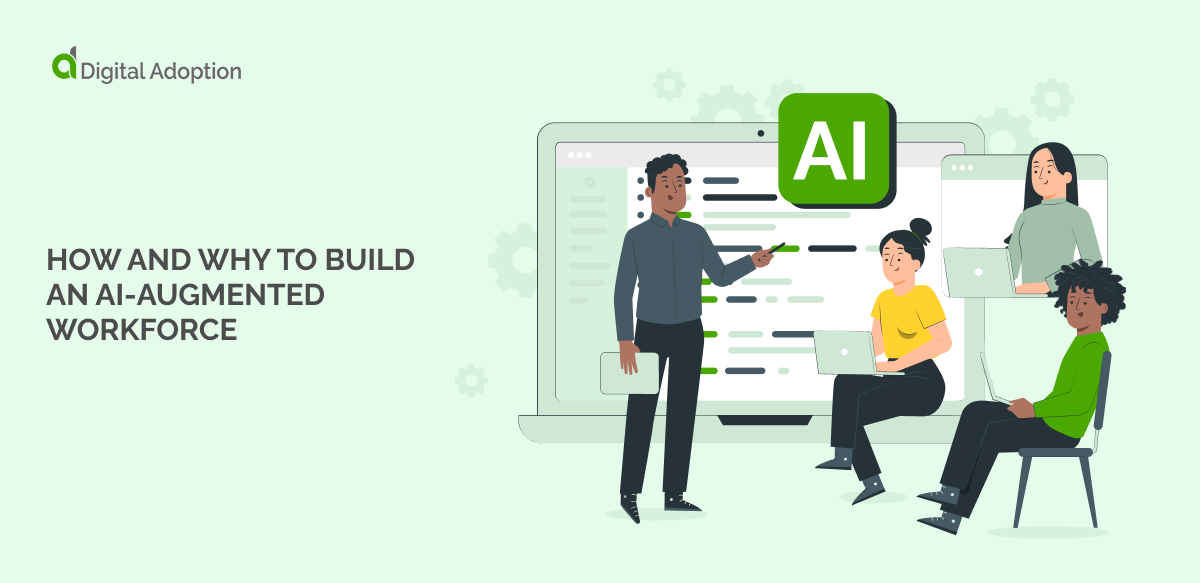



![18 Examples of AI in Finance [2025]](https://www.digital-adoption.com/wp-content/uploads/2025/06/18-Examples-of-AI-in-Finance-2025-300x146.jpg)
![14 Examples of AI in Manufacturing [2025]](https://www.digital-adoption.com/wp-content/uploads/2025/06/14-Examples-of-AI-in-Manufacturing-2025-300x146.jpg)
![29 Examples of AI in Education [2025]](https://www.digital-adoption.com/wp-content/uploads/2025/06/29-Examples-of-AI-in-Education-2025-300x146.jpg)
![15 Examples of AI in Retail [2025]](https://www.digital-adoption.com/wp-content/uploads/2025/06/15-Examples-of-AI-in-Retail-2025-300x146.jpg)



![18 Examples of AI in Finance [2025]](https://www.digital-adoption.com/wp-content/uploads/2025/06/18-Examples-of-AI-in-Finance-2025.jpg)
![14 Examples of AI in Manufacturing [2025]](https://www.digital-adoption.com/wp-content/uploads/2025/06/14-Examples-of-AI-in-Manufacturing-2025.jpg)